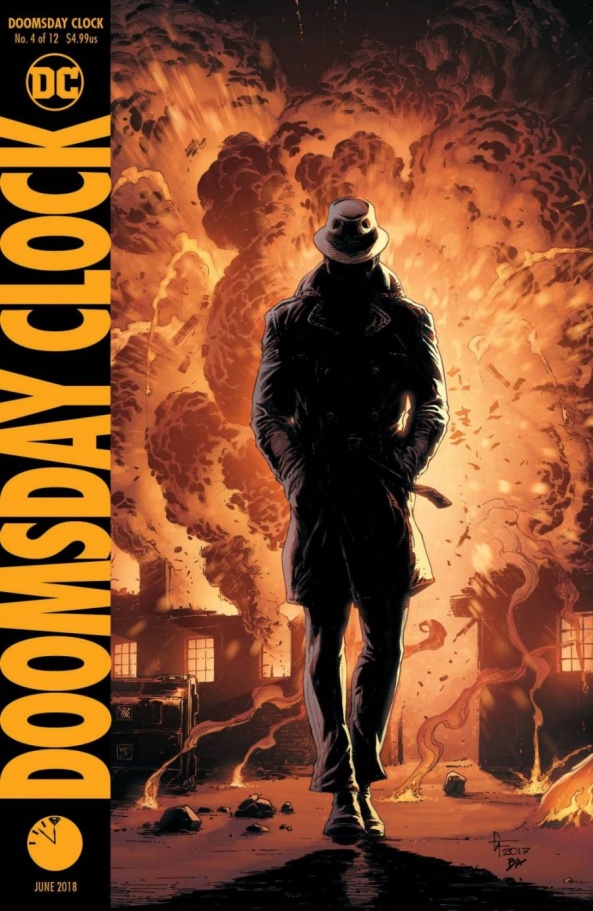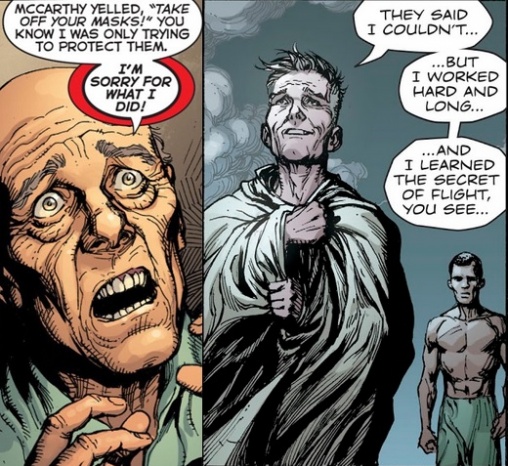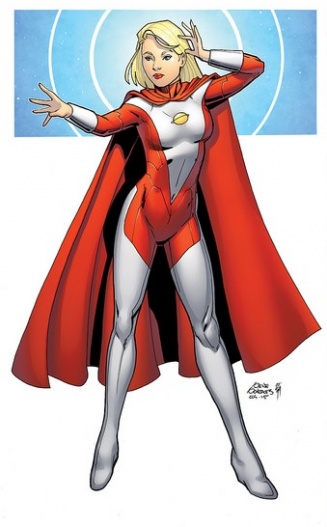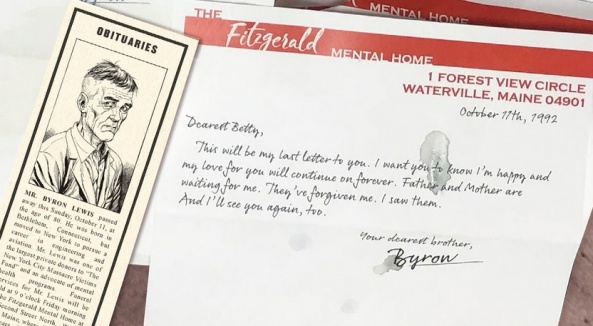Welcome to “Keeping a Watch on Doomsday Clock,” our column dedicated to annotating the first ever DCU/Watchmen crossover that most of us probably didn’t need but is here nonetheless! Since this 12-issue maxiseries relies so heavily on “Watchmen,” a comic that has a ton to unpack in itself, there are a lot of details and references to look at. This time around we dig deep into the new Rorschach’s past.
The cover image depicting pancakes is basically repeated in the first panel, again following the “Watchmen” rule of the cover being the first panel almost, but not quite. The variant cover with Rorschach walking away from a burning building immediately brings to mind the sixth chapter of “Watchmen,” which focused on the original Rorschach’s psyche and backstory. “Doomsday Clock” #4 serves a similar purpose but this time for the second bearer of the title. “Watchmen” #4 was also a character-focused piece, albeit about Dr Manhattan.

We begin with Rorschach in Arkham Asulym, where he was confined by Batman at the end of the previous issue. The pancakes of the cover and the first panel turn out to not even exist, as Rorschach actually is standing in the food queue to receive only a spatter of slimey porridge on his plate. Rorschach imagining the cakes on his plate ties into a “you see what you want to see” line of thought that will be very prevalent throughout this issue. The panel of him standing in the line is very similar to the original Rorscach queueing for food in prison in “Watchmen” #6. The other inmates in the line aren’t named but could be guessed to be The Ventriloquist, Professor Milo, Maxie Zeus, Zebra-Man and The Scarecrow. Zebra-Man offers to take Rorschach under his protection. The zebra pattern on his forehead, shaped like a mushroom cloud, takes us into a flashback sequence that fully confirms the identity of Rorschach. He is revealed to be the son of Dr Malcolm Long, the psychiatrist who evaluated Walter Kovacs. The threat of nuclear destruction scares young Reggie, who is five years old at the time when Dr Manhattan interferes in the Vietnam War. This happened in 1971 according to “Watchmen,” so Reggie would have been born around 1966. This means he would be 26 years old now. Mr Freeze can be seen staring out at Reggie while he is being dragged by the guards. His appearance of a blue-skinned, cold-minded bald man is quite clearly reminiscent of Dr Manhattan. As we see at the end of this issue, this isn’t the only echo of Dr Manhattan in Arkham Asulym.

Reggie continues to think back to his youth in his cell while watching a mosquito fly into a blue-lighted bug zapper and fry itself. He apparently took psychology classes in college in his father’s footsteps. When psych class is cancelled because of protests, Reggie starts driving home. Now we see the scene of him being trapped behind a taxi from a different perspective and the light of the squid attack. Here the light is blue, whereas in “Watchmen” the scene was first coloured in a green hue, then completely white. Remembering this and the death of his parents sends Reggie into a screaming rage, which is interrupted when his new psychologist called Matthew Mason enters the cell. We go back to the flashback sequence which gets more and more disturbing as Reggie remembers his time in Fitzgerald Asylum, Maine in the “Watchmen” universe. The psychological effects on those who would survive the squid attack weren’t nearly as vital to Adrian Veidt’s plan as the millions who died, but here it can be seen that the consequences were vast. On the roof of Fitzgerald, Reggie meets an old man who is an important character for the rest of the issue. Byron Lewis aka Mothman was one of the masked adventurers who belonged to the Minutemen. He is a quite minor character in “Watchmen,” having been hospitalized before the main events of the series. The attached documents of “Doomsday Clock” #1 included Lewis’s obituary, saying he died in a fire at Fitzgerald. Here Byron is seen escaping the asylum in a makeshift Mothman costume only to enjoy some good food and buy some stuff to smuggle in before being caught again.
Continued below
An interesting parallel to Byron Lewis is DCU’s Johnny Thunder, also an old retired superhero locked up against his will. Johnny Thunder was seen in “Doomsday Clock” #3 and “DC Universe: Rebirth.” In the latter he spoke about having to tell the JSA to disappear when faced with a government act which forced superheroes to unmask. This is very similar to what happened to the Minutemen in the “Watchmen” universe when the Keene Act was passed. A minor detail to note in the first scene between Reggie and Byron is that Byron mentions humans having a seasonal clock, to add to the clock references sprinkled throughout the series. He then explains to Reggie his “secret of flight” by giving us the central thought of this issue: “I see what I want to see. And what I see is what is.”

This idea is easily applicable to a Rorschach test. Reggie seeing a moth in the test parallels the “I see a pretty butterfly” scene from “Watchmen” #6. Still, they’re very different scenes. Walter Kovacs lied to Dr Long about what he saw, but Dr Long’s son here decides to see a moth instead the death of his parents because Lewis and his philosophy have inspired him. The “see what you want to see” idea is also very different from Walter Kovacs’s strict black and white worldview. An alliance forms between Reggie and Byron and one day Byron smuggles in a very special gift for Reggie: everything from Dr Malcolm Long’s desk. The majority of notes Dr Long made about Rorschach have been stolen, though. The “dad” mug was actually seen in “Watchmen,” a small detail giving Geoff Johns a nearly irresistible opportunity in developing a character for “Doomsday Clock.” Reggie begins training with Byron and thus gains a way of taking action, but he is still missing a goal. This is symbolized by the puzzle piece portraying Adrian Veidt’s face missing from the puzzle. One day Byron finds the final puzzle piece and afterwards, when Veidt’s crimes are exposed on TV, Reggie gets someone to blame. When taking the Rorschach test again, Reggie simply tells the doctors he sees Rorschach, who was become his new guiding light.

Survivors of the squid attack are being rounded up in Washington DC, but Reggie has other plans. He convinces Byron to escape Fitzgerald Asylum with him. Reggie sets the building on fire to allow their escape, paralleling Walter Kovacs burning up the criminal’s house in “Watchmen” #6. Reggie has to leave alone as Byron walks back into the fire at the critical moment of their run, quite literally like a moth drawn to a flame. He claims to see something in the fire, but what he sees is left a mystery to Reggie. Reggie boards a ship called Percy Bysshe, having received the ticket along with the original Rorschach mask from Byron as a final gift. Percy Bysshe Shelley’s poem ‘Ozymandias’ was discussed in the first issue’s annotations. Veidt’s brain cancer is a glioblastoma, which is a very aggressive type of brain tumour. Its symptoms can vary a lot, including personality changes and symptoms similar to having a stroke. Reggie gives up on trying to kill Veidt when Veidt tells him that he regrets putting his plan to action and that he saw the light too late. The word ‘light’ especially seems to halt Reggie.
Light is a reoccurring motif throughout the issue, and one that is closely entwined with enlightenment. Reggie remembers his father saying everyone is searching for enlightenment in some form and thinks the light is different for everyone. Enlightenment is what the “you see what you want to see” idea essentially is for Byron Lewis and later, Reggie. It’s notable that light isn’t just a positive thing, as Reggie remembers the blue light that appeared before the squid attack and two insects and an insect-themed old superhero die being drawn to a light of some kind.

Returning to the present day and the DC universe, psychiatrist Matthew Mason is revealed to be Batman in disguise. Pretending to be Dr Mason he most likely keeps as a secret from the staff, but what raises questions is they way he locked Reggie up in Arkham in the first place. It seemed like a weird custom that even the notoriously lousy Arkham would allow Batman to drop anyone into a cell there without any evaluation and despite Reggie having committed no crimes on this Earth yet. Is there an actual rule that Batman can just bring people in or does the staff not care? Reggie is in his cell contemplating the “you see what you want to see” idea again when he gets a visitor. This Jane Doe is actually Saturn Girl aka Imra Ardeen from the Legion of Super-Heroes. She was also seen in “DC Universe: Rebirth” and the “Batman”/”The Flash” crossover ‘The Button,’ both of which lead up to “Doomsday Clock.” Saturn Girl has telepathic powers with which she has been looking into Reggie’s mind and thus is the only one in the DCU who believes what happened to him was real. She now comes to Reggie to escape Arkham together with him. When Saturn Girl introduces herself as a friend, Reggie remembers Byron Lewis, with whom he escaped a mental hospital for the first time.
Continued below
The ending page offers a twist. We see Reggie’s now empty cell, suddenly with the photograph taken of Jon Osterman aka Dr Manhattan and his girlfriend Janey Slater at Palisades Amusement Park floating to the floor. A mosquito flies into the blue bug zapper on the opposite wall again. The smoke from the dead mosquito forms the shape of a hydrogen atom’s orbital model, which is Dr Manhattans logo. It isn’t completely clear whether the mosquito actually hit the zapper of was it killed by a zap of Manhattan’s powers seconds before, but the smoke indicates the latter. This means that Dr Manhattan was present in the asylum after all, coincidentally to the lie Batman told to Rorschach about his whereabouts. Was he just visiting for this moment or was he there in disguise the whole time?

A lot of things happen twice in this issue with some variation. Reggie is incarcerated in two mental hospitals on two Earths. He escapes both with the help of a superhero, the other being an old man and the other a woman literally from the future. Two mosquitos are fried in different ways. A lot of the central ideas are repeated in the dialogue multiple times. The symmetry doesn’t extend to the structure of the issue: Johns and Frank don’t attempt anything like the structurally symmetric “Watchmen” #5 here.
The issue’s ending quote is from Linji Yixuan, the founder of the Linji school of Chán Buddhism who lived in 900th century China. “The miracle is not to walk on water. The miracle is to walk on Earth” certainly goes with the enlightenment theme and Byron Lewis’s philosophy of finding appreciation for things even when there maybe isn’t much to appreciate. The attached documents are a collection of letters from Byron to his younger sister Betty. They’re not included as much to provide background information or clues to the series’ future as much to add some emotional impact. Like I said earlier, Lewis doesn’t really get that much exposure in “Watchmen.” Here the creators of “Doomsday Clock” give him a lot more space, painting a perhaps more positive picture of the old man than Moore and Gibbons did in the short scenes and mentions of him. The friend who Byron mentions having died in a car crash is Captain Metropolis aka Nelson Gardner, another member of the Minutemen. The original Rorschach mentions in “Watchmen” #1 that Gardner was decapitated in a car accident in 1974. In what he knows to be his last letter to Betty, Byron mentions having seen his dead parents. His parents probably aren’t what he saw when he walked to the fire however, since he called that vision “it,” which doesn’t indicate people. What Byron saw in his final moments remains as a mystery.

The Nathaniel Dusk story within a story wasn’t continued in this issue, as it would have been quite unfitting for the very Rorschach-focused narrative. The ‘Tales of the Black Freighter’ story didn’t appear in every “Watchmen” issue either after its beginning. Yet again we were scarcer on real world references and instead took a tighter look at some very specific elements. Come back after a few months to see “Doomsday Clock” #5 annotated!




